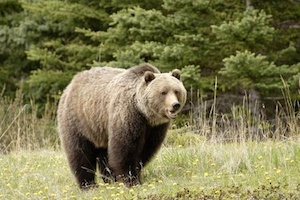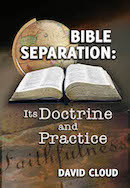866-295-4143, fbns@wayoflife.org

Most subspecies of the brown bear are massive, with males averaging six to nine feet in length, standing five feet at the shoulder. They weigh 500 to 1200 pounds, largely depending on diet and habitat. The Kodiak rivals the polar bear as the largest member of the bear family and the largest land-based predator. It is 10 feet tall when standing on its hind legs.
The male is about 50% larger than the female.
The brown bear can range in color from blond to gray to black.
The brown bear can be distinguished from the black bear by the following traits:
• The Grizzly has a shoulder hump.
• The Grizzly has a concave snout that is shorter than a black bear’s.
• The Grizzly has a part in the hair on its head above its snout
• The Grizzly’s ears are short and rounded; the black bears' are longer.
• The Grizzly’s claws are much longer.
The brown bear is more widely distributed than any other bear and occupies territory from the Arctic wilderness to temperate rain forests.
The brown bear’s life expectancy is about 20 years in the wild and 30 years in captivity.
It eats almost anything, from insects to moose, but plants, roots, mushrooms, nuts, and fruit form their main diet. They love fish, and those that feast on salmon put on weight quickly. A brown bear has his favorite fishing spot, and tries to “reserve” it from other bears (BearLife.org).
The brown bear is usually a solitary animal except for the female and her cubs and except for when they congregate at favorite fishing spots to feed on salmon.
The brown bear can be a fierce man killer. Tellingly, the Grizzly’s Latin name is Ursus arctos horribilis. There are an average of two fatal bear attacks per year in North America. Attacks often occur when a bear is surprised or guarding a kill or when a female is defending her cubs. In a few cases, the bear has eaten its victim. Richard White was killed and eaten in Denali National park in Alaska in 2012. He was taking photos from about 50 yards away, when the bear charged. White actually photographed the bear turning toward him and beginning to move his way before the tragic attack. He had broken the park rule to stay at least a quarter mile away from the animals.
Grizzly Man is a documentary film about Timothy Treadwell, a young man who thought he could befriend the bears in Alaska’s Katmai National Park. Ignoring repeated warnings by park rangers and others, he and his girlfriend were killed and eaten by one of his “friends” in 2003. Treadwell’s own video camera recorded the audio of the attack. The only thing that was left was one of his arms bearing his wristwatch.
The brown bear can easily outrun a human. They have been clocked at 30 miles per hour and can maintain that pace for two miles. It is said that a bear equals the strength of five tall, muscular men, and an enraged bear equals more than that.
When in an aggressive mode, the bear snorts, roars, growls, and snaps its teeth.
The best defense against a bear attack is good quality bear spray. A high powered gun is good at a distance, but it can be nearly useless if the bear initiates the attack from close quarters, as often is the case, and it is moving at the speed of a locomotive. Bear spray has been known to stop an enraged mama Grizzly in her tracks. The spray is high velocity, shooting out about 30 feet, and is highly potent. When in bear country, it is wise to have the spray gun handy for a quick draw and to be practiced in the art!
Hibernation
Except in warmer habitats, the brown bear hibernates in the winter, usually from about October to March.
In preparation for hibernation, the bear will eat as much as 90 pounds of food a day. It can lose as much as half of its body fat during the winter sleep.
The female digs her den as much as a month before hibernation. Typically, it is composed of a tunnel four feet long leading to a chamber about five feet in diameter. The den is often built on a steep or moderately steep slope.
During hibernation, the bear undergoes “profound changes in body chemistry, metabolism, breathing rate, and moderate changes in body temperature” (“Brown Bear,” San Diego Zoo). The process is a biological miracle that God has programmed into the bear’s genetic constitution. If a human being tried to hibernate, he would die, of course. He would quickly dehydrate and starve. Even if a human remains in a reclining position for long periods, though he eats and drinks, he loses muscle and bone mass and otherwise deteriorates physically.
But the bear is designed to hibernate. Though it doesn’t sleep all winter, it rests and doesn’t eat, drink, urinate, or defecate, yet it doesn’t dehydrate or starve or suffer muscle and bone loss.
“Researchers believe that they have found the chemical in a bear’s blood that prevents bone loss during long inactivity. The chemical is under study for possible use in treating human osteoporosis. Bears avoid bathroom visits by chemically changing their own waste back into proteins. The fact that scientists study how things in the creation work to improve how we do things is a tribute to the workmanship of the Creator, even if scientists refuse to admit His existence and activity” (“The Bear Facts about Good Health,” Creation Moments, Dec. 5, 2014).
Breeding and Cubs
The female brown bear doesn’t breed until it is five-six years old. In a process called delayed implantation, the fertilized egg floats free within the uterus until “nature” activates it to attach to the uterine wall and grow. This happens after the female begins hibernation so that the cub is born at the right time. “Should the mother not gain enough weight to survive through the winter, the embryo will not implant and will be reabsorbed into the body” (“Brown Bear,” New World Encyclopedia).
The female averages two cubs, though four is not uncommon. It is not unusual for the female to adopt stray cubs. Newborns weigh only about one pound and are blind, toothless, and nearly hairless at birth. They are born during hibernation and nurse until spring. (And they continue to nurse for the next 1.5 to 2.5 years.) The cubs spend two and a half years with the mother, learning hunting and survival skills before venturing out on their own. During those years, the female tries to avoid males, as they might try to kill the cubs. The female will defend them against the much larger male at the cost of her life.
Smell
“Grizzly bears have a sense of smell seven times greater than that of a bloodhound, and 100 times that of a human by some estimates. Grizzlies also possess a Jacobson’s organ in the roof of their mouth that can detect heavier moisture-borne odors. Scientists tracked the bear as it appeared to smell an elk carcass from four miles away, follow the scent and even wound up swimming across the lake to get to it” (“GPS Study Tracks Grizzlies as They Follow Hunters,” Fox News, Nov. 24, 2014).
Ethyl’s Amazing Trek
One Grizzly trekked 2,800 miles through Montana and Idaho over a three-year period from 2012 to 2014. She crossed high mountains, rivers, towns, even an interstate freeway. It is thought that she was trying to find her way back to the area from whence she was removed for raiding apple orchards. At that time she was tagged with a radio collar that sent weekly GPS data packets to a satellite. Agents with the U.S. Fish and Wildlife Service named the wide-roaming bear Ethyl.
Bears in the Bible
The bear is mentioned 12 times in Scripture, and the Hebrew word “dob” means to move slowly (1 Sa. 17:34, 36, 37; 2 Sa. 17:8; 2 Ki. 2:24; Pr. 17:12; 28:15; Isa. 11:7; 59:11; La. 3:10; Ho. 13:8; Am. 5:19).
The Syrian bear (Ursus arctos syriacus) is one of 16 types of the brown bear clan that includes the North American grizzly. While not as big as the grizzly, the Syrian bear is still a monster weighing up to 550 pounds.
This is the type of bear that David killed (1 Sa. 17:34).
The Bible teaches us to learn spiritual lessons from creation, and the mother bear’s ferocity is often used as an illustration (2 Sa. 17:8; Pr. 17:12; Ho. 13:8). Few things in nature are more fearful than a mother brown bear that is defending her cubs. She lies in wait (La. 3:10) and then attacks quickly and unexpectedly, running 35-40 miles an hour (50 yards in a blazing 3 seconds), and tearing her opponents apart with her sharp claws and terrible teeth.
In Hosea 13:8, God warns Israel that He would be to her in judgment as a bear bereaved of her whelps, and in the next verse He says, “in me is thine help.” Like the mother bear, God is a wonderful protector and a terrible enemy.
The Syrian bear was thought to be extinct in Lebanon, Israel, and Syria, but a mother and cub were sighted in Lebanon’s Bekaa Valley in December 2016 (“Extremely rare Syrian bear and cub spotted in Lebanon,” Independent, Jan. 13, 2017).
- Receive these reports by email
- www.wayoflife.org
______________________
Sharing Policy: Much of our material is available for free, such as the hundreds of articles at the Way of Life web site. Other items we sell to help fund our expensive literature and foreign church planting ministries. Way of Life's content falls into two categories: sharable and non-sharable. Things that we encourage you to share include the audio sermons, O Timothy magazine, FBIS articles, and the free eVideos and free eBooks. You are welcome to make copies of these at your own expense and share them with friends and family. You may also post parts of reports and/or entire reports to websites, blogs, etc as long as you give proper credit (citation). A link to the original report is very much appreciated as the reports are frequently updated and/or expanded. Things we do not want copied and distributed are "Store" items like the Fundamental Baptist Digital Library, print editions of our books, electronic editions of the books that we sell, the videos that we sell, etc. The items have taken years to produce at enormous expense in time and money, and we use the income from sales to help fund the ministry. We trust that your Christian honesty will preserve the integrity of this policy. "For the scripture saith, Thou shalt not muzzle the ox that treadeth out the corn. And, The labourer is worthy of his reward" (1 Timothy 5:18). Questions? support@wayoflife.org
Goal:Distributed by Way of Life Literature Inc., the Fundamental Baptist Information Service is an e-mail posting for Bible-believing Christians. Established in 1974, Way of Life Literature is a fundamental Baptist preaching and publishing ministry based in Bethel Baptist Church, London, Ontario, of which Wilbert Unger is the founding Pastor. Brother Cloud lives in South Asia where he has been a church planting missionary since 1979. Our primary goal with the FBIS is to provide material to assist preachers in the edification and protection of the churches.
Offering: Offerings are welcome if you care to make one. If you have been helped and/or blessed by our material offerings can be mailed or made online with with Visa, Mastercard, Discover, or Paypal. For information see: www.wayoflife.org/about/makeanoffering.html.





